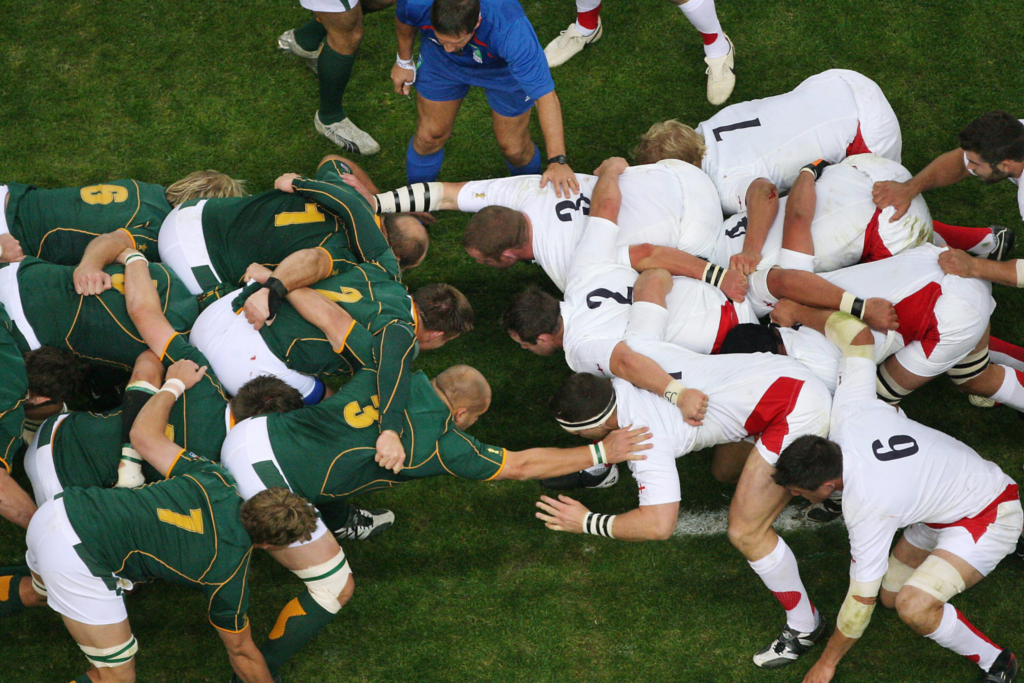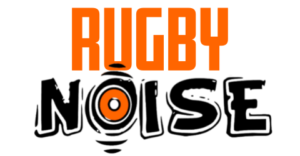Nothing is perhaps more entertaining in the sport of rugby than seeing the players from the opposing teams lock horns in a scrum. It is a true display of both raw unadulterated strength and skill that has to be mastered for years to be executed safely and effectively. Like most other team sports, rugby has players who specialize in certain aspects of the game – those whose main concern is to score tries, those who excel at stifling their opponents’ offensive attempts, and those whose main role is to ensure that their side retains possessions in 50-50 situations like breakdowns and scrums.
Who are the scrum players in rugby? The scrum players in rugby are traditionally eight in number: the hooker, two props (tighthead prop and loosehead prop on the right and left side of the hooker in the front row respectively), two locks, two flankers (openside flanker and blindside flanker) and the number eight.

In rare instances where a team has less than 15 players on the field of play, a referee may allow a scrum to be formed by a few players. The minimum number of players required is five: the hooker and the two props in the front row and two locks. A team is however not required to match the number of players on the opposing team’s side and can rightfully field the standard number of players.
What Does Scrum Mean in Rugby?
A scrum is a short form of the word scrummage and is a way of restarting play in rugby football after a minor infraction or contravention of the Laws. Examples include cases where either team makes a forward pass or knocks the ball on (where a player from either team knowingly or unknowingly knocks the ball out of an opposing player’s hands or possession towards the desired direction in order to get an undue advantage).
Scrums are quite more common in the rugby union than in the rugby league and are the preferred way of resuming play whenever play is broken. Another good example of an instance where a scrum is ideal is when there are messy rucks or mauls, which are common, if not the norm, after a breakdown (a brief period of open play where possession can swing either way).
Most rugby teams train particular players to engage in a scrum. These players are chosen largely because of their skill (area of expertise) and physical attributes (size and strength). Since a scrum basically provides either team with a “fighting” chance to get possession of the ball, it only makes sense that the more skilled and physically gifted will naturally have a greater chance at winning.
The different Stages of a Scrum
In the rugby union, scrums are governed by Law 19 of the Laws of the Game. Law 19 spells out the type of infractions or stoppages that can result in a scrum, the location where a scrum should be held in relation to where an infraction or stoppage occurs, and the team that is expected to introduce the ball into the scrum.
The law also highlights how a scrum should be formed, the rules of engagement (up to and including the introduction of the ball), and the penalties for any attempts to circumvent the rules. The location where a scrum occurs is indicated by the referee and is referred to as a scrum zone.
Teams are afforded just 30 seconds to get ready for a scrum failure to which a free kick is awarded to the opposing team. To form a scrum, the props first position themselves to either side of the hooker and bind to him/her with the hooker doing the same forming the first row.
The two locks then bind to the props by getting into the two spaces between the first row and also bind to each other. The two flankers then bind to the two locks with at least one arm depending on which side they are covering. Flankers tend to use the arm that is the closest to the lock in order to have a clear line of sight to the opposing team in case they may need to attempt an interception.
The number eight then binds to the space between the two locks completing the scrum. The opposing teams then face each other with the hookers positioned at the centermost point of the scrum zone. The teams are usually less than an arm’s length from each other as they await the referee’s instructions to engage.
“Game Time”
Once both sides are properly positioned and sturdy, the referee calls out “bind”. This is a signal for the front rows of both teams to bind. Tighthead props bind to the loosehead props of the opposing team and grip onto their jersey at either the shoulder or the back.
The referee then calls out “set”, which is a signal for the teams to engage so as to create the tunnel into which the ball will be introduced. The referee finally calls out “throw”, which motions the scrum-half to introduce the ball. The ball should then be introduced in one single movement, without delay and quickly.
Any attempts to delay introducing the ball into the tunnel or to manipulate the direction in which the ball should go result in a free kick for the opposing team. Any attempts to engage at an awkward angle, pull, push or undertake any action meant to collapse the scrum are equally penalized.
The players in the front row (the hooker and two props) may attempt to gain possession of the ball by controlling it to their side. They must however do it without using their hands and using only one foot, not both. Contravening this rule results in the opposing team being awarded a penalty.
Once the balls leave the scrum, the referee tells the respective team to “use it”. The team must then ensure that they play the ball out of the scrum within five seconds. If they fail to do so, the referee calls for a fresh scrum. The task of introducing the ball into the tunnel is equally awarded to the opposing team’s scrum-half.
All players who do not participate in a scrum are required to stay at least five meters behind the hindmost foot of the outermost player on their team. A scrum is considered to have successfully ended if it exits the tunnel in any other direction other than the one it was introduced to. Teams prefer having their scrum-half pick up the ball and play it on once it reaches the feet of their hindmost player.
A scrum may also end when the ball is picked up off the feet of a second-row player by the number eight, when the ball is on or over the goal line, or when the referee blows his/her whistle to signal an infringement.
